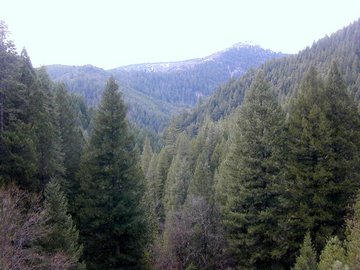Forest
|
|
A forest is an area with a high density of trees (or, historically, an area set aside for hunting). Plant communities covering large areas of the globe provide carbon-sink, oxygen-release, habitat, and soil-retention functions. Therefore, Earth's forests constitute one of the most important aspects of our biosphere.
Forests can be found in all regions capable of sustaining tree growth, at altitudes up to the tree-line, except where natural fire frequency is too high, or mankind has intervened. Forests generally contain a large number of different tree species growing to different heights, combined with an understory, which makes efficient use of sunlight. A forest in its natural form is home to many animal and plant species, and biomass per unit area is high compared to most other biomes, though in some types of forests such as boreal forests, much of it is locked in lignin and other materials that decompose slowly.
In ecological terms, a forest may be differentiated from a woodland: A forest has a more or less closed canopy, in which the branches and foliage of trees meet or interlock. A woodland has an open canopy, which allows some sunlight to penetrate between the trees (see also: savanna).
Forest1.jpg
Numerous types of forests exist. Among the ecological types are:
- rain forest (tropical and temperate)
- taiga
- temperate hardwood forest
- tropical dry forest
Forests are usually classified in terms of the biome in which they exist, and in terms of leaf longevity of the major species (whether they are evergreen or deciduous). Boreal forests occupy the subarctic zone and are generally evergreen and needle-leaved. Temperate zones support both deciduous forests (e.g., temperate deciduous forest) and evergreen forests (e.g., temperate rainforest, chaparral). Tropical and subtropical forests include tropical rainforest, tropical moist forest and tropical dry forest.
The science of studying and managing forests, with a goal of sustainable extraction, is called forestry. Some ecologists also study forests.
Forests can be damaged by logging, forest fires, and acid rain. In the United States, most forests have been destroyed at some point, though in recent years environmental protection has allowed for a comeback in many areas. In a number of places, forests have been allowed, for one reason or another, to grow back.
| Contents |
See also
Forest_on_San_Juan_Island.jpg
General
- Biosphere
- Ecological succession
- Jungle (terrain)
- Plant
- Plantation
- Rainforest
- Royal forest
- Temperate broadleaf and mixed forests
- Temperate coniferous forests
- Tree
- Tropical and subtropical coniferous forests
- Tropical and subtropical moist broadleaf forests
Activities related to forest
- Controlled burn
- Deforestation
- Forest engineering
- Logging and illegal logging
- Reforestation
- Shifting cultivation

